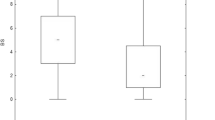Abstract
The collagen content of resected strictured intestine, with and without fistulas, from patients with Crohn's disease has been compared with that in macroscopically normal intestine removed from the same patients and from others without inflammatory bowel disease. Collagen content per unit wet or dry weight of tissue was significantly increased in all grossly diseased tissue whether fistulated or not. Although there was a significant increase in collagen types I, III, and V in diseased tissue, the relative proportions of major collagen types extracted by limited pepsin digestion were similar for both Crohn's and non-Crohn's intestine (type I, 65 to 70 percent; type III, 25 to 30 percent; type IV, 2 to 3 percent; and type V, 2.5 to 3 percent). CNBr digestion of pepsin insoluble material showed a similar relative abundance of types I and III, indicating no major change in collagen type distribution between older (insoluble) and more newly synthesized collagen. There was no evidence of the presence of type I trimer collagen. Type VI collagen, although not quantitated, was observed in 70 percent of intestinal specimens. The proportion of total collagen solubilized by pepsin treatment was significantly greater in both grossly diseased and macroscopically normal Crohn's bowel compared with non-inflammatory bowel disease bowel. These findings suggest that there are disturbances of collagen metabolism in Crohn's intestine, which account for the stricturing process and which may predate gross pathologic changes.
Similar content being viewed by others
References
Greenstein AJ, Kark AE, Dreiling DA. Fistula in Crohn's disease of the colon, classification, presenting features and management in 63 patients. Am J Gastroenterol 1974;62:419–29.
Mekjian HS, Switz DM, Melnyk CS, Rankin GB, Brooks RK. Clinical features and natural history of Crohn's disease. Gastroenterology 1979;77:898–906.
Graham MF, Diegelmann RF, Elson CO, Gay S, Gay R. Abnormal accumulation of basement membrane (type IV) and cytoskeletal (type V) collagens in the strictures of Crohn's disease. Ann N Y Acad Sci 1985;400:439–42.
Durdy P, Switala S, Williams NS. Collagenolytic activity in Crohn's colitis. Br J Surg 1987;74:527.
Gerson MF, Fabry EM. Ascorbic acid deficiency and fistula formation in regional enteritis. Gastroenterology 1974;67:428–33.
Levene CT, Ockleford CD, Barber CL. Scurvy: a comparison between ultrastructural and biochemical changes observed in cultured fibroblasts and the collagen they synthesise. Virchous Arch [B] 1977;23:325–8.
Pettit SH, Irving MH. Does local intestinal ascorbate deficiency predispose to fistula formation in Crohn's disease. Dis Colon Rectum 1987;30:552–7.
Abedin MZ, Ayad S, Weiss JB. Isolation and native characterisation of cysteine-rich collagens from bovine placental tissue and uterus and their relationship to types IV and V collagens. Biosci Rep 1982;2:493–502.
Weiss JB, Sedowofia K, Jones C. Collagen degradation: a defended multi-enzyne system. In: Viidik A, Vuust J, eds. Biology of collagen. New York: Academic Press, 1980:113–34.
Graham MF, Diegelmann RF, Lindblad WJ, Elson CO. Increased collagen content and type V collagen in the strictures of Crohn's disease. Gastroenterology 1987;92:1412.
Graham MF, Elson CO, Diegelmann RF. Increased proportions of type V and type I trimer collagens in the intestinal strictures of Crohn's disease. Gastroenterology 1986;90:1436.
Timpl R, Engel J. In: Burgeson RE, Mayne R, eds. Structure and function of collagen types. New York: Academic Press, 1988:105–43.
Madden JW, Peacock EE Jr. Some thoughts on repair of peripheral nerves. South Med J 1971;64:17–21.
Graham MF, Diegelmann RF, Elson CO, et al. Collagen content and types in the intestinal strictures of Crohn's disease. Gastroenterology 1988;94:257–65.
Gay S, Gay R, Miller EJ. The collagens of the joint. Arthritis Rheum 1980;23:937–41.
Laemmli UK. Cleavage of structural proteins during the assembly of the head of bacteriophage T4. Nature 1970;227:680–5.
Sykes B, Puddle B, Francis M, Smith R. The estimation of two collagens from human dermis by interrupted gel electrophoresis. Biochem Biophys Res Commun 1976;57:717–25.
Stegemann H, Stalder K. Determination of hydroxyproline. Clin Chim Acta 1967; 18:267–73.
Davies PF, Mackle ZM. A simple procedure for the separation of insoluble collagen and elastin. Anal Biochem 1981;115:11–7.
Scott PG, Veis A. The cyanogen bromide peptides of bovine soluble and insoluble collagens. II. Tissue specific crosslinked peptides of insoluble skin and dentin collagen. Connect Tissue Res 1976;4:117–29.
Laurent GJ, Cockerill P, McAnulty RJ, Hasting JR. A simplified method for quantitation of the relative amounts of type I and type III collagen in small tissue samples. Anal Biochem 1981;113:301–12.
Author information
Authors and Affiliations
About this article
Cite this article
Alexander, A.C., Irving, M.H. Accumulation and pepsin solubility of collagens in the bowel of patients with Crohn's disease. Dis Colon Rectum 33, 956–962 (1990). https://doi.org/10.1007/BF02139105
Issue Date:
DOI: https://doi.org/10.1007/BF02139105




